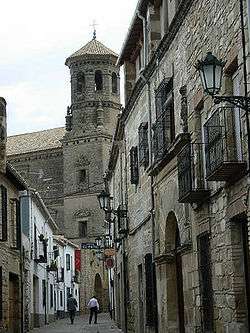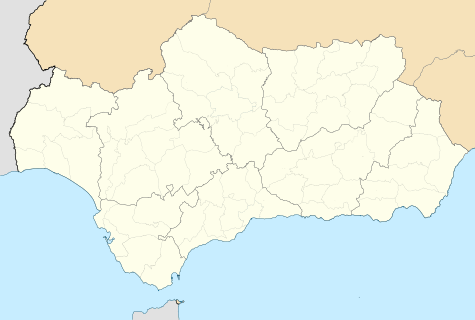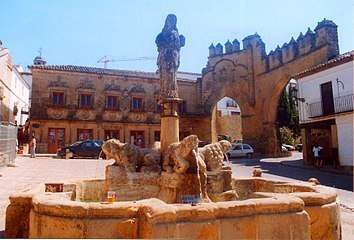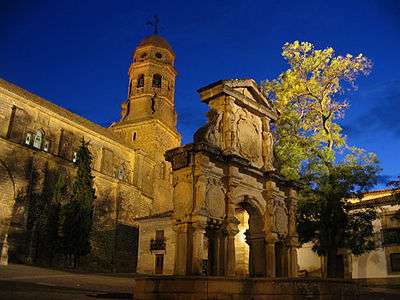Baeza
| Baeza | |||
|---|---|---|---|
| Municipality | |||
 | |||
| |||
 Baeza Location in Andalusia | |||
| Coordinates: 37°59′N 3°28′W / 37.983°N 3.467°W | |||
| Country |
| ||
| Autonomous community |
| ||
| Province | Jaén | ||
| Comarca | La Loma | ||
| Judicial district | Baeza | ||
| Government | |||
| • Mayor | Leocadio Marín Rodríguez (PSOE) | ||
| Area | |||
| • Total | 194.3 km2 (75.0 sq mi) | ||
| Elevation | 769 m (2,523 ft) | ||
| Population (2009) | |||
| • Total | 16,253 | ||
| • Density | 84/km2 (220/sq mi) | ||
| Demonym(s) | Baezanos | ||
| Time zone | UTC+1 (CET) | ||
| • Summer (DST) | UTC+2 (CEST) | ||
| Postal code | 23440 | ||
| Website | Official website | ||
| UNESCO World Heritage site | |||
| Part of | Renaissance Monumental Ensembles of Úbeda and Baeza | ||
| Criteria | Cultural: (ii), (iv) | ||
| Reference | 522rev-002 | ||
| Inscription | 2003 (27th Session) | ||
| Area | 4.8 ha (12 acres) | ||
| Buffer zone | 176 ha (430 acres) | ||
Baeza (Spanish pronunciation: [baˈeθa]), formerly also written as Baéza,[1] is an Andalusian town in the province of Jaén in southern Spain. It lies perched on a cliff in the Loma de Úbeda, the range separating the Guadalquivir River to its south from the Guadalimar to its north. It is now principally famed for having some of the best-preserved examples of Italian Renaissance architecture in Spain. Along with Úbeda, it was added to UNESCO's list of World Heritage Sites in 2003. The former Visigothic bishopric of Baeza remains a Latin Catholic titular see.
History
The town stands at a high elevation about 3 miles (4.8 km) from the right bank of the Guadalquivir[2] in the Loma de Úbeda.[1] Under the Romans, the town was known as Beatia.[2] Following its conquest by the Visigoths, Beatia was the seat of a bishopric of Baeza (viz.), which was suppressed after a period under Moorish rule. Baeza reached its greatest prosperity under Islamic rule, when it formed the capital of an effectively independent ?emirate and reached a population of around 50,000.[2] Remnants of the Moors' fortifications include the town's Jaén and Úbeda gates and the Arch of Baeza.[2]
The Christian diocese was reëstablished in 1127 or 1147 following the town's conquest by Alfonso VII of Castile, but it was then reconquered by the Muslims and its cathedral adopted as a mosque. The town never recovered from the destruction endured upon its conquest by Ferdinand III of Castile in 1227 or 1239.[2] The diocese of Baeza was merged with Jaén in 1248[1] or 1249, but was later nominally restored as a titular see of the Roman Catholic Church.[3]
The red dye made from a local cochineal came to be celebrated[2] and a second era of lesser prosperity occurred in the 16th century, when Baeza and nearby Úbeda grew rich from their textile industry. Local nobles hired major architects of the era (including Andrés de Vandelvira) to design the present cathedral, churches, public buildings, and private palaces in the then-fashionable Italian style. The town's university building dates to 1533.[2] The economy collapsed in the 17th century, with the only remaining industry consisting of local production of grain and olive oil. As few newer structures were built during this period, this had the effect of preserving the town's Renaissance legacy. The university closed for a time before being reopened by the 19th century[2] as a seminary. In the 1870s, the population was around 11,000;[2] over the next few decades, the Linares–Almeria railway was constructed nearby and town's population grew to 14,000 by 1900.[1]
Landmarks
Baeza still houses several fine public buildings:
- The former Baeza Cathedral is built over a former mosque. It was first used in Christian service in the 12th century during Castile's first period of rule. It was then used as a mosque before its reconquest in the 13th century. The most ancient parts are the cubic base of the bell tower and three (presently hidden) Islamic arches. Most of the present Renaissance-influenced Gothic structure—including the nave with two aisles, pilasters, and crossed vaults—dates to around 1529. The tower was redone in 1549 and the Chapel of St Michael was added in 1560. Construction was completed under Andrés de Vandelvira.
- Town Hall (Ayuntamiento), a Plateresque building originally built as a combined courthouse and prison, leading to two separate main entrances
- Baeza University, established in 1533[2] or 1538, now a secondary school
- Santa Cruz Church, a Romanesque church with a two-aisle nave and semicircular apse. A side wall incorporates a Visigothic arch.
- St Paul's Church, a Gothic church with a Renaissance portal with a two-aisle nave and Gothic chapels. Includes the tomb of Pablo de Olavide.
- The Chapel of St Francis, in the ruins of a Renaissance building from 1538 formerly used as a monastery[1]
- Jabalquinto Palace (Palacio de Jabalquinto), including an Gothic entrance flanked by two cylindrical pilasters with Plateresque capitals with mocárabes, a Renaissance courtyard, and a Baroque staircase
- Spain Plaza (Plaza de España)
- Constitution Plaza (Plaza or Paseo de la Constitucíon), including a marble fountain decorated with Caryatides[2]
- St Mary Fountain (1564)
- The Fountain of the Lions, from the Ibero-Roman ruins of Cástulo and possibly representing Himilce, wife of the Carthaginian general Hannibal
- The Úbeda and Jaen[2] or Cordova[1] gates
- The Villalar Arch (Arco de Villalar), erected for Charles V's 1526 visit to honor his 1521 victory at Villalar.
- Seminary or oratorio of St Philip Neri[2] (1660)
Transportation
Baeza is 327 km (203 mi) south of Madrid by highway. The Linares–Baeza RENFE railway station is 15 km (9 mi) away to the southwest; it lies on the Linares-Almeria line. There are bus connections to Granada, Málaga, and Madrid. Granada (132 km or 82 mi) and Málaga (241 km or 150 mi) are the nearest international airports.
Notable locals
- Saro, bishop (c. 862)
- Domingo, bishop (1236–1249), Dominican monk, and former bishop of Marocco from 27 October 1225 – 1236
- Gaspar Becerra, sculptor and painter
- St John of Ávila, Christian mystic
- St John of the Cross, Christian mystic
- Pablo de Olavide
- Antonio Machado, modernist poet whose most notable prose work Juan de Mairena is thought to have been inspired by his time as a teacher in Baeza (1912–1919)
International relations
Baeza is twinned with:

Gallery
- Palacio de Jabalquinto
- Iglesia de la Santa Cruz
- Iglesia de San Pablo
 Fuente de los Leones
Fuente de los Leones- Fuente de Santa Maria
- Cattedrale
 Ayuntamiento
Ayuntamiento Council Seminary cloister, from Antonio Machado headquarter of International University of Andalusia
Council Seminary cloister, from Antonio Machado headquarter of International University of Andalusia Santa María fountain and cathedral of Baeza
Santa María fountain and cathedral of Baeza
See also
Notes and references
Sources and external links
| Wikimedia Commons has media related to Baeza. |
- Official site for the municipal government
- "Renaissance Monumental Ensembles of Úbeda and Baeza", World Heritage Sites, UNESCO
- Ubeda and Baeza site
- Baeza, Spanish Ministry of Education, Culture and Sport
- "Baeza", former and titular see GigaCatholic Check
|url=value (help) - Romanesque church at Baeza
- Image Gallery of Baeza
- Baeza eGuide
- ebaeza.com eBaeza guide
Bibliography


.svg.png)
.svg.png)